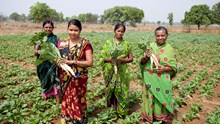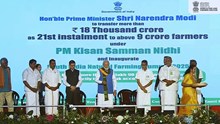
India is one of the world’s leading producers of black pepper, a spice prized not only for its distinctive flavor but also for its medicinal properties. To boost productivity and ensure better quality, the Indian Council of Agricultural Research – Indian Institute of Spices Research (ICAR-IISR) has developed several high-yielding and disease-resistant black pepper varieties. The following is a detailed overview of some of the most notable varieties introduced by ICAR-IISR.
1. Sreekara
This variety is a selection from Karimunda (KS 14), well-suited for cultivation in Kerala and Southern Karnataka. It falls under the medium maturity group, making it adaptable to the climatic conditions of these regions.
Yield Potential
Under standard growing conditions, this variety produces approximately 2677 kg of dry pepper per hectare. The yield can reach up to 4200 kg per hectare with optimal care and favorable environmental factors. Additionally, the average yield per vine is around 4.8 kg of green pepper, with a dry recovery rate of 35%, ensuring substantial post-harvest returns.
Special Characteristics
-
Adaptable to various climatic conditions.
-
Produces high-quality pepper with excellent pungency.
2. Subhakara
Subhakara is a selection from Karimunda (KS 27), well-suited for cultivation in Kerala and Southern Karnataka. It falls under the medium maturity group, making it adaptable to the climatic conditions of these regions.
Yield Potential
Under standard growing conditions, this variety produces approximately 2352 kg of dry pepper per hectare. With optimal care and favorable environmental factors, the yield can potentially reach up to 4487 kg per hectare. Additionally, the average yield per vine is around 4.2 kg of green pepper, with a dry recovery rate of 35.5%, ensuring substantial post-harvest returns.
Special Characteristics
-
High-quality pepper with wider adaptability across pepper-growing regions.
3. Panchami
Panchami is a selection from Aimpiriyan (Coll.856), well-suited for cultivation in Kerala and Karnataka. This variety falls under the late maturity group, making it an ideal choice for growers seeking a pepper variety with an extended growth cycle.
Yield Potential
This variety falls under the late maturity group and produces approximately 2828 kg of dry pepper per hectare under standard conditions. When cultivated under optimal care and favorable environmental factors, its yield potential can reach up to 6528 kg per hectare. Additionally, the average yield per vine is around 5.2 kg of green pepper, with a dry recovery rate of 34%, ensuring significant post-harvest returns.
Special Characteristics
-
High-yielding variety with excellent fruit set.
-
Spike appears twisted due to high fruit density.
-
High oleoresin content, making it valuable for spice extraction.
4. Pournami
Pournami is a selection from the germplasm (Coll.812) and is well-suited for cultivation in Kerala and Karnataka. It belongs to the medium maturity group, making it adaptable to the climatic conditions of these regions.
Yield Potential
Under standard growing conditions, this variety produces approximately 2333 kg of dry pepper per hectare. When cultivated under optimal care, its yield potential can reach up to 5356 kg per hectare. Additionally, the average yield per vine is around 4.7 kg of green pepper, with a dry recovery rate of 31%, ensuring substantial post-harvest returns.
Special Characteristics
-
Tolerant to root knot nematode, enhancing its resilience.
-
Moderately high yielding variety with high oleoresin content.
5. PLD-2
PLD-2 is a selection from Kottanadan (Coll.2559), well-suited for cultivation in the Trivandrum and Quilon districts. This variety falls under the late maturity group, making it an excellent choice for growers seeking a pepper variety with an extended growth cycle.
Yield Potential
This variety falls under the late maturity group and produces approximately 2475 kg of dry pepper per hectare under standard conditions. Under optimal care and favorable environmental factors, its yield potential can reach up to 4731 kg per hectare. Additionally, the average yield per vine is around 4.97 kg of green pepper, with a dry recovery rate of 31.13%, ensuring substantial post-harvest returns.
Special Characteristics
-
High oleoresin content, making it valuable for spice extraction.
-
Adaptable to different pepper-growing regions.
6. IISR-Thevam
IISR-Thevam is a clonal selection from Thevanmundi and was officially released in 2004. It is well-suited for cultivation in both high-altitude areas and plains, making it a versatile choice for pepper growers.
Yield Potential
This variety falls under the medium maturity group and provides an average yield of 5.17 kg of fresh pepper per vine. Additionally, it has a dry recovery rate of 35%, ensuring substantial post-harvest returns.
Special Characteristics
-
Tolerant to foot rot diseases, improving survival in affected regions.
-
Suited to high-altitude areas for optimal growth.
7. IISR-Malabar Excel
This variety is a hybrid of Cholamundi × Panniyur-1 and is well-suited for cultivation in high-altitude regions. It falls under the medium maturity group, making it adaptable to the environmental conditions of these areas.
Yield Potential
Under standard growing conditions, this variety provides an average yield of 2.78 kg of fresh pepper per vine. Additionally, it has a dry recovery rate of 34%, ensuring substantial post-harvest returns.
Special Characteristics
-
Thrives in high-altitude regions, making it ideal for such conditions.
8. IISR-Shakthi
IISR-Shakthi is an open-pollinated progeny of Perambramundi, well-suited for cultivation in both plains and high ranges under rain-fed conditions. Its adaptability makes it a reliable choice for diverse growing environments.
Yield Potential
This variety falls under the medium maturity group and provides an average yield of 5.216 kg of fresh pepper per vine. Additionally, the dry yield per hectare is around 2253 kg, with a dry recovery rate of 43%, ensuring substantial post-harvest returns.
Special Characteristics
-
Tolerant to Phytophthora foot rot, making it suitable for disease-prone areas.
8. Arka Coorg Excel
This variety is a seedling selection, officially released in 2012. It is well-suited for cultivation in the Kodagu district and similar regions, making it a reliable choice for pepper growers in these areas.
Yield Potential
Under standard growing conditions, this variety provides an average yield of 7.15 kg of fresh pepper per vine. Additionally, it has a dry recovery rate of 40%, ensuring substantial post-harvest returns.
Special Characteristics
-
Adapted to Kodagu district, making it well-suited for similar Agro-climatic conditions.
Quality Attributes of Black Pepper Varieties
|
Variety Name |
Piperine (%) |
Oleoresin (%) |
Essential Oil (%) |
|
Sreekara |
5.1 |
13.0 |
7.0 |
|
Subhakara |
3.4 |
12.4 |
6.0 |
|
Panchami |
4.7 |
12.5 |
3.4 |
|
Pournami |
4.1 |
13.8 |
3.4 |
|
PLD-2 |
3.0 |
15.45 |
4.8 |
|
IISR-Thevam |
1.6 |
8.5 |
3.1 |
|
IISR-Girimunda |
2.2 |
9.65 |
3.4 |
|
IISR-Malabar Excel |
2.96 |
13.5 |
3.2 |
|
IISR-Shakthi |
3.3 |
10.2 |
3.7 |
Among these black pepper varieties, Sreekara contains the highest piperine content (5.1%), making it a strong choice for enhancing spice intensity. PLD-2 stands out for its high oleoresin percentage (15.45%), which is valuable for extraction purposes. Essential oil concentration varies across the varieties, with Sreekara leading at 7.0%. These differences emphasize the unique characteristics of each variety, catering to diverse culinary, medicinal, and industrial applications.
The black pepper varieties released by ICAR-IISR represent significant advancements in spice cultivation, offering high yields, disease resistance, and superior quality traits. These varieties have been carefully developed to enhance productivity while ensuring adaptability to diverse agro-climatic conditions. With characteristics such as high piperine content, improved oleoresin levels, and tolerance to key diseases, these cultivars contribute to the sustainable growth of India's pepper industry.
















